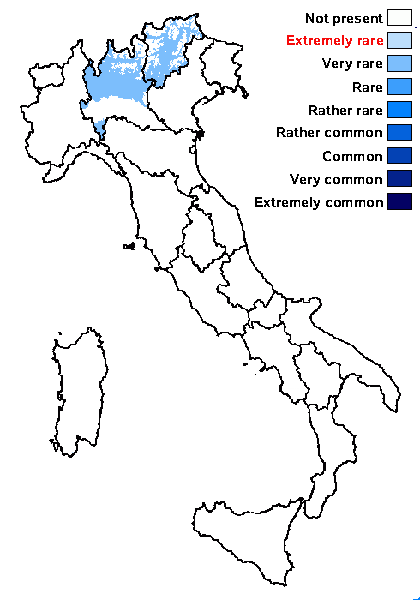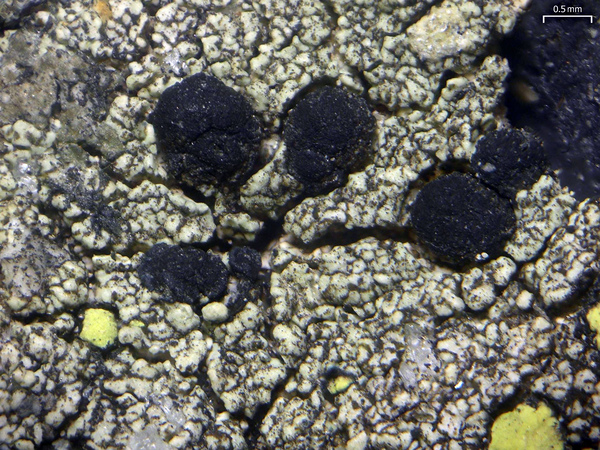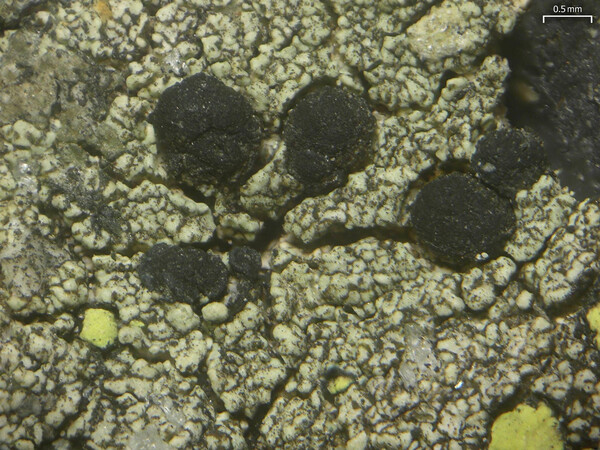Lecidella granulosula (Nyl.) Knoph & Leuckert
Herzogia, 14: 9, 2000. Basionym: Lecidea granulosula Nyl. in Crombie - Journ. Bot., 14: 21, 1876.
Synonyms: Lecidea chodatii Samp.; Lecidea goniophiloides B. de Lesd.; Lecidella chodatii (Samp.) Knoph & Leuckert; Lecidella viridans var. chodatii (Samp.) Hertel & Leuckert
Distribution: N - TAA (Knoph & Leuckert 2000), Lomb (Knoph & Leuckert 2000).
Description: Thallus crustose, episubstratic, yellowish grey to grey-white, usually granular, rarely continuous, 0.1-0.5 mm thick. Medulla white, I-. Apothecia lecideine, black, semi-immersed to sessile, slightly constricted at base, 0.3-0.8 mm across, with a flat to weakly convex, epruinose disc, and a raised, persistent proper margin. Proper exciple dark blue-green and N+ red in outer part, pale brown within, without crystals; epithecium green, to olive-green, N+ red; hymenium colourless, 50-70 µm high, not inspersed with oil droplets; paraphyses easily made free in K, simple, rarely branched and anastomosing, 1-2 µm thick at mid-level, the apical cell 3-5 µm wide; hypothecium colourless, partly strongly filled with crystals, Asci 8-spored, clavate, with an intensely K/I+ blue tholus penetrated by a faintly amyloid, broadly cylindrical axial mass, and a poorly developed ocular chamber, the wall K/I-, surrounded by a K/I+ blue outer layer, approaching the Lecanora-type. Ascospores 1-celled, hyaline, broadly ellipsoid, 10-14 x 5-8 µm, thick-walled. Pycnidia black, globose. Conidia thread-like, slightly curved, 14-20 µm long. Photobiont chlorococcoid. Spot tests: thallus K- or K+ yellow, C+ orange or rarely C-, KC+ orange or KC-, P- or rarely P+ yellow, UV+ orange. Chemistry: chodatin, demethylchodatin, 2,5,7-trichloro-3-O-methylnorlichexanthone, 5,7-dichloro-3-O-methylnorlichexanthone, isoarthothelin, and thiophanic acid.
Note: on basic siliceous rocks, probably restricted to dry-warm Alpine valleys in Italy.
Growth form: Crustose
Substrata: rocks
Photobiont: green algae other than Trentepohlia
Reproductive strategy: mainly sexual
Subcontinental: restricted to areas with a dry-subcontinental climate (e.g. dry Alpine valleys, parts of Mediterranean Italy)
Commonnes-rarity: (info)
Alpine belt: absent
Subalpine belt: absent
Oromediterranean belt: absent
Montane belt: very rare
Submediterranean belt: very rare
Padanian area: absent
Humid submediterranean belt: absent
Humid mediterranean belt: absent
Dry mediterranean belt: absent

Predictive model
Growth form: Crustose
Substrata: rocks
Photobiont: green algae other than Trentepohlia
Reproductive strategy: mainly sexual
Subcontinental: restricted to areas with a dry-subcontinental climate (e.g. dry Alpine valleys, parts of Mediterranean Italy)
Commonnes-rarity: (info)
Alpine belt: absent
Subalpine belt: absent
Oromediterranean belt: absent
Montane belt: very rare
Submediterranean belt: very rare
Padanian area: absent
Humid submediterranean belt: absent
Humid mediterranean belt: absent
Dry mediterranean belt: absent

Predictive model
 Index Fungorum
Index Fungorum
 GBIF
GBIF



